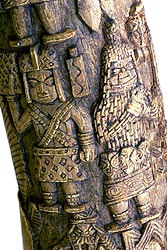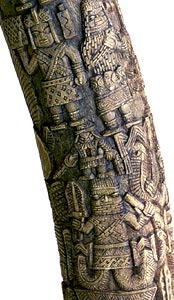|
Ivory
During the reign of Oba Akenzua I (about 1715 to 1735) ivory was a highly valued commodity and an important trade item. The Iyase
n'Ode's power base was in the village of Oregbeni (oar-egg-ben-EE), the locale of the elephant hunter's guild. That may explain his
legendary association in Benin oral tradition with the elephant. His struggles with the oba may have been over control of the profitable
ivory trade that began late in the 17th century.
Art in Benin
Most Benin art is made to glorify the oba and to pay homage to past obas. This art expresses the special power and privileges of
kingship and reinforces the complex hierarchy of the court.
One of the most popular forms of Benin art is the carved ivory tusk. These tusks, which are displayed atop sculpted bronze heads
representing Benin's rulers, symbolically record the stories of Benin's illustrious history. Most tusks are carved for altars dedicated
to the oba. A few, like this one, are made for the altars of particularly powerful ezomos in their own courts.

|
Detail of relief carving from the Memorial Tusk |

|
Roll over the image to see details from the Memorial Tusk |
Memorial Tusk
Rich patterns of human and animal figures carved in low
RELIEF
cover the entire surface of this carved elephant's tusk.2 Working with small, sharp tools, the artists chipped, shaved, and carved away
bits of the ivory so that the figures project out from the
BACKGROUND
core of the tusk.
Many of the images on this tusk celebrate the Ezomo Ehenua's defeat of the Iyase n'Ode and the restoration of the monarchy. Rather than
illustrate every detail of an event or story, the artist symbolically evokes the story and its significance. Over generations Benin
artists arrived at
ABSTRACT
images that all viewers could readily recognize and interpret.
An ezomo stands at the base of the tusk. In his right hand he holds a sword to indicate his military prowess. The diagonal band of rectangles
across his chest and the rings of small rectangles around his neck represent the coral-beaded
REGALIA
worn at the oba's court. A typical figure type in Benin art, he is short with small legs and an oversized head. On each side of the
ezomo is a barely visible (because of abrasion) abstract image of an elephant's trunk that turns into a hand holding leaves. These
symbolize extraordinary physical strength and knowledge.3
Above the ezomo stands the oba. He wears similar regalia and grabs an elephant trunk in each of his hands to symbolize his strength. Above
his head is a leopard, another symbol of his power, since both the oba and the leopard were admired for their strength, agility,
fierceness, and cunning.
Abstract representations of elephants appear throughout this tusk. A few curved lines make its eyes, and many straight lines emanate from a long curving
central line to create its powerful trunk. Elephant images such as this one are still identified today as the Iyase n'Ode, the oba's
magical and dangerous opponent. By recalling Ezomo Ehuena's victory over the terrible elephant-chief, the tusk asserts and reinforces
the power of the present ezomo as well. It also reminds viewers that the right to inherit the position of ezomo was granted by the
grateful oba.
1 The oba was considered to be divine. He was the intermediary between his divine ancestors and the Benin people and, therefore, personally
controlled the divine forces that affect the entire kingdom. Traditionally, he was both a politically and a religious leader. Today,
the oba maintains religious responsibility for his people, although his political powers have been reduced over time.
2 The color of ivory also represents an important quality of kinship, because its whiteness recalls the color of chalk, a symbol of ritual
purity that is associated with Olokum, God of the Sea. In the 19th century trade in ivory was a monopoly of the king, who was entitled
to one tusk from every elephant slain in the kingdom.
3 The trunk-hand motif - an elephant uses it's trunk like a hand - is a symbol of the strength of a king. The leaves are medicinal forest leaves
whose secret properties are known only to special warriors.
|











